Northampton Town
On the 6th March 1897 a group of school teachers and a prominent local solicitor resolved to form a professional association football club to be called Northampton FC. Following objections from Northampton Rugby Club, it was decided to adopt the name Northampton Town instead. After two seasons in the Northamptonshire League, the club moved up to the Midlands League and adopted the municipal claret and white colours. In 1901, the Cobblers (so named because the town was the centre of the boot and shoe manufacturing industry) joined the Southern League.
In 1920 the Cobblers became founder members of Division Three when the Southern League First Division was incorporated into the League. There was not a great deal to celebrate, however, as the club settled into mid-table obscurity for the next 18 years, although they did finish as runners-up in 1928. (In those days, only the champions of the two regional third divisions were promoted.) In the mid 1930s the club adopted a distinctive hooped jersey, the first of many innovative designs.
After the Second World War, Northampton fared little better (although they were again runners up in 1950). Photographic evidence indicates that the team switched between plain claret shirts and the old hooped versions with bewildering frequency in the seasons immediately after the war. Club historian, Frank Grande writes, "I do remember reading during my research that the club were asking for any spare clothing coupons and one of the players of the era stating that whenever they went down injured the manager was more worried about the shirt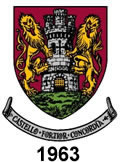 than the player!"
than the player!"
When the regional divisions were scrapped in 1957, the club was placed in Division Four. The 1960s proved to be a remarkable decade for the club. Promoted in 1961, Northampton were Division Three champions in 1963 and in 1965 they won promotion to the First Division. After their success of 1963, the town's coat of arms was added to the teams' shirts where it was worn until 1967.
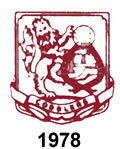 Having risen from the Fourth to the First Divisions, their decline was equally spectacular. Relegated after one season at the top, by 1972 they were applying for re-election to the Fourth Division!
Having risen from the Fourth to the First Divisions, their decline was equally spectacular. Relegated after one season at the top, by 1972 they were applying for re-election to the Fourth Division!
Promotion in 1976 was followed by immediate relegation and the side finished twice more in the re-election zone in 1982 and 1985. During this period a new crest appeared between 1978 and 1982 when it was replaced by a simple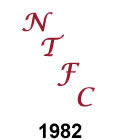 monogramme. When the team switched from predominantly white shirts to an all-claret kit in 1983 (notoriously hard to see under the County Ground's rather poor floodlighting), a stylised letter "C" appeared in place of a crest. This may well have been to acknowledge financial help from Carlsberg, who have their main UK brewery in the town.
monogramme. When the team switched from predominantly white shirts to an all-claret kit in 1983 (notoriously hard to see under the County Ground's rather poor floodlighting), a stylised letter "C" appeared in place of a crest. This may well have been to acknowledge financial help from Carlsberg, who have their main UK brewery in the town.
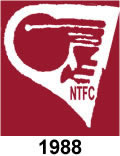 In 1987, with ex-player Graham Carr in charge the Cobblers were Fourth Division champions and narrowly missed out on the play-offs the following season. Another new crest appeared in 1988, a semi-abstract affair based on a ball being struck by a football boot.
In 1987, with ex-player Graham Carr in charge the Cobblers were Fourth Division champions and narrowly missed out on the play-offs the following season. Another new crest appeared in 1988, a semi-abstract affair based on a ball being struck by a football boot.
Financial pressures forced the club to sell off their best players and they were relegated once again in 1990. In April 1992, with debts of around £1.6m, the club went into administration and ten first team players were sacked to save money, their places being taken by youth players. In 1994, Northampton finished bottom of the League and should have been relegated to the Conference. They were reprieved when Kidderminster Harriers, the Conference champions, were denied promotion because their ground did not meet League standards. There was considerable irony in this as 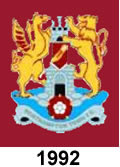 Northampton were generally acknowledged as having the worst ground in the League and would certainly have been refused promotion had the positions been reversed.
Northampton were generally acknowledged as having the worst ground in the League and would certainly have been refused promotion had the positions been reversed.
It was in 1992 that a proper crest was introduced, based loosely on the Northampton coat of arms but with sufficient differences to make it distinctive. These included a slipper, celebrating the area's long association with shoe-making.
Since their formation, Northampton Town had been tenants of Northamptonshire Cricket Club with whom they shared the County Ground. The south side of the ground remained open to accommodate the cricket club's outfield and could not be developed while the wooden stand on the north side had to be demolished after the Bradford City fire in 1985. This was replaced with a temporary structure while the east and west terraces crumbled behind the goals.
After interminable wrangling, the Borough Council finally approved a plan to build a brand new stadium on an old rubbish tip at the edge of town. Reclamation involved installing vents to prevent methane gas building up under the site. In October 1994, the club moved into their compact new Sixfields Stadium. Three years later, in their centenary year, the Cobblers were promoted via the play-offs. The following season they reached the play-off finals but this time lost to Grimsby. A year later, the Cobblers were relegated. In 2000, they were again promoted to Nationwide Division Two but, true to form, they were relegated three years later than promoted again three years after that. This pattern continued in the first decade of the new millennium as the team were promoted and relegated between the lower divisions with bewildering regularity.
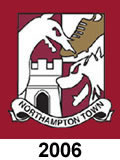 Northampton's choice of playing strips is as unpredictable as their recent career. Since the 1960s, the predominant colour of the Cobblers' kits alternated between white and claret, including some extravagant designs but in the new millennium they have worn more traditonal claret shirts. On at least two occasions, however, the club deviated from its traditional
Northampton's choice of playing strips is as unpredictable as their recent career. Since the 1960s, the predominant colour of the Cobblers' kits alternated between white and claret, including some extravagant designs but in the new millennium they have worn more traditonal claret shirts. On at least two occasions, however, the club deviated from its traditional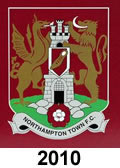 claret colour, to the disgust of their hardcore supporters.
claret colour, to the disgust of their hardcore supporters.
In 2006 the board decided on yet another change of image and a new crest was designed. This featured elements from the traditional badge but rendered in a dramatic, modernist style. This crest proved unpopular with supporters who mounted a campaign for the traditional crest to be reintroduced. Their pressure was successful and for the 2010-11 season, a smart new version of the older badge was introduced.
